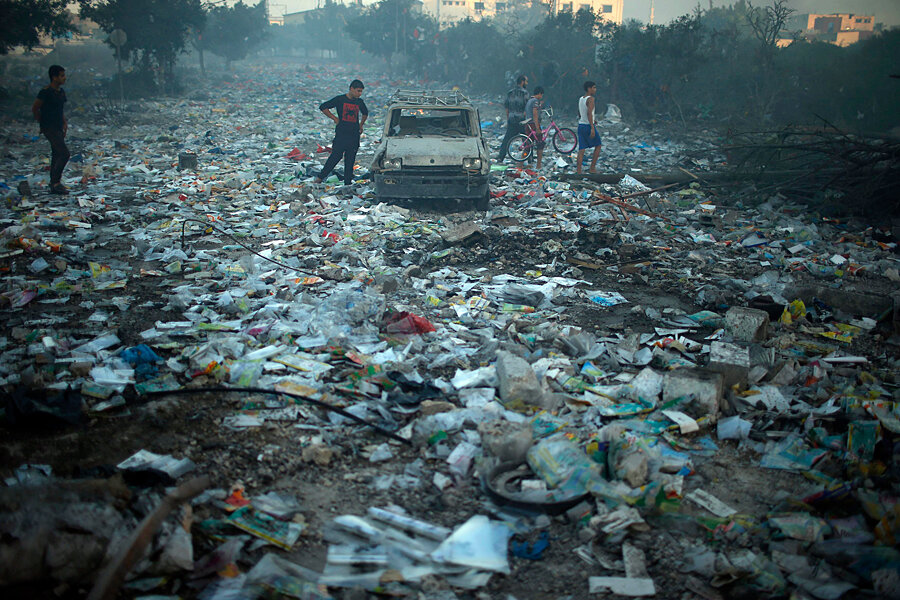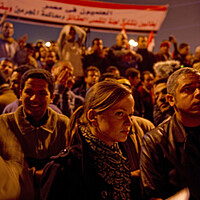Attempted evacuation, then shells take 15 lives at Gaza shelter
Loading...
| Beit Lahiya, Gaza Strip
An attack on a shelter for displaced civilians this afternoon in north Gaza killed at least 15 people and wounded more than 200.
Witnesses said more than 1,000 people were gathered in the courtyard of the UN school-turned shelter in Beit Hanoun, waiting for buses to take them to a safer place, when the site was shelled, mowing down the crowd and leaving a gruesome scene in the place they had sought safety. It marked yet another strike – suspected to have come from Israeli forces – that took a heavy toll on civilians during a conflict that has killed more than 788 Palestinians in Gaza and 34 Israelis, two of them civilians.
Outside a hospital where many of the dead and wounded were brought, Hussein Shimbary sat on the ground and cried, his clothes and hands bloodied. He was in the school's courtyard with his family when the explosions hit, and was the only one from his family left unscathed. His mother, his father's second wife, two of his young brothers, and his sister were killed.
“How can I describe these scenes – I saw pieces of bodies around me,” he says.
His family's home – which is now destroyed – is on Gaza's northeastern border with Israel, an area that has seen intense fighting since Israel launched a ground invasion one week ago. They fled to the school at the start of the ground invasion “because we were told it was a safe place,” he says.
Later, however, people who had been staying at the shelter said they had been warned to leave by officials because it was unsafe.
Nearby, a young girl screamed and cried, trying to pull away from family members who were walking toward the morgue. Women behind her who had just learned of their relatives' death wept and wailed, and one nearly fainted. In the morgue, a toddler wearing a ruffled, blood-stained shirt and pink pants lay on a wooden table as hospital workers wrapped her in a white burial shroud.
A spokeswoman for the Israeli military said that Beit Hanoun is a “combat area,” and that Hamas uses civilian infrastructure and “international symbols” as human shields. She said the military is reviewing the incident. The Official Israeli Defense Force (IDF) Twitter account later acknowledged that Israeli forces had fired on the area, also saying that Hamas had fired rockets that landed in the area. It also said it had warned both the Red Cross and the United Nations Relief and Works Agency (UNRWA) to evacuate the shelter overnight.
Multiple witnesses described multiple explosions in the attack on the shelter and said they appeared to be shelling from Israeli tanks positioned within range of the school. Christopher Gunness, spokesman for the organization running the shelter, the United Nation's Relief and Works Agency (UNRWA), wrote on Twitter that UNRWA had given precise coordinates for the location of the shelter to the Israeli military. He also wrote that UNRWA attempted to coordinate with the Israeli army an evacuation window for civilians today and that “it was never granted.”
Today was not the first time a UN shelter for displaced people was hit by Israeli fire during this conflict. Gunness said there have been four direct hits from Israeli fire on three shelters in the last three days.
UNRWA has also discovered two rocket caches hidden inside vacant schools, and condemned their storage there. More than 140,000 Palestinians in Gaza have taken refuge in UNRWA shelters.
Chaos prevailed inside the Kamal Adwan hospital as doctors rushed to treat the wounded. A little girl's shoes and pants, apparently torn off to treat her wounds, lay under a bloody stretcher. The man laying on it, Monther Hamdan, had bloody bandages on his legs, and a relative stood holding his hand.
He says officials told the residents they had to leave the shelter, so they gathered in the courtyard with their belongings.
“After 45 minutes, the tanks started bombing like rain,” he says. He was with his 13-member family, most of them children, and said all of them were injured.
He lived near the school but brought his family there three days ago because his home was in danger.
“We believed this school was more safe than our house,” he says.






